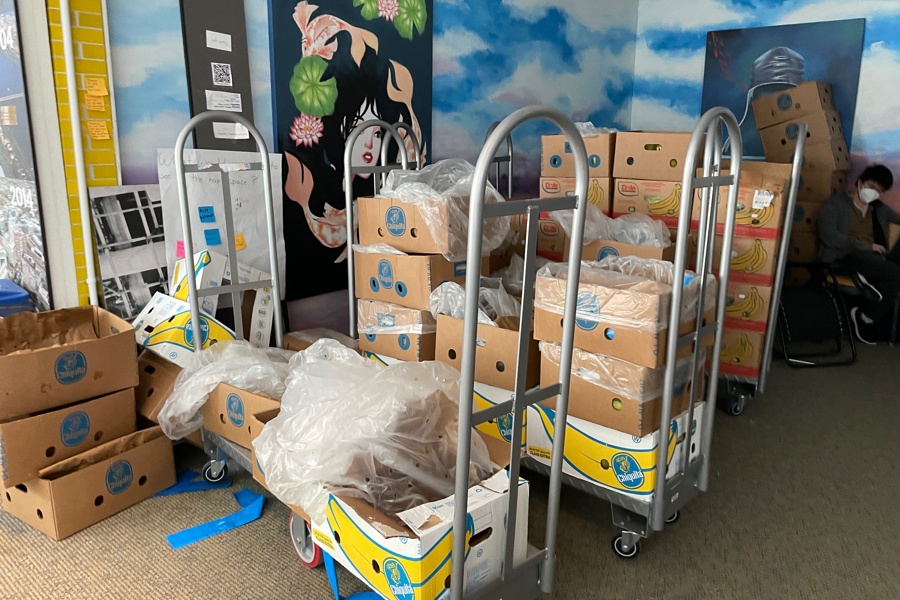The World Needs More Ideas Like the MIT Banana Lounge
It's a brilliant, beautiful concept: Distribute thousands of free bananas, every day, for free.

Photo by Iain Cheeseman/Twitter
I eat a banana, like, every day. I try to, anyway. A banana is a phenomenal snack: an inexpensive, delightful, and sweet yet guilt-free treat packed with vitamins and nutrients, and one which has the added benefit of coming wrapped in its own easy-to-hold natural packaging. I am an unrepentant banana-vangelist, and anytime someone complains about a cramped-up muscle, you better believe they’re getting The Potassium Talk from the likes of me. Eat bananas.
So I was elated to learn this week about a phenomenon concocted by the brainiacs at MIT called the MIT Banana Lounge. The details were shared by similarly elated MIT professor Iain Cheeseman in a series of tweets on Monday:
Welcome to the inside story of the MIT Banana Lounge.
If you’re just tuning in, I learned about a fantastical room @MIT full of bananas. As an MIT faculty member + free food lover, it blew my mind. I recently met with the @MITBananaLounge team – amazing secrets now revealed! pic.twitter.com/p1DumFAP5Q
— Iain Cheeseman (@iaincheeseman) April 11, 2022
The concept is a simple and beautiful one. It is, as the name suggests, a lounge on MIT’s campus that is absolutely loaded with crates upon crates of bananas. Students can drop by and pick up a banana real quick at any time, for free.
Why does the Banana Lounge exist? Well, for one thing, this is part of a long tradition of whimsy at MIT, in line with things like the Simmons Hall ball pit, the annual piano drop, Smoots, and “the Milk.” But there are some real-world impacts to be gleaned from this particular zany idea. Even at MIT, a storied institution overflowing with prestige, about 13 percent of undergrads surveyed in 2018 said they sometimes had trouble accessing food. Sometimes a free, perfectly ripe, and ready-to-eat banana is a fun little perk. Sometimes it’s the nutritional boost a food insecure student needs to make it from class to class.
As for the lounge itself, you can find it in a room in the institute’s Compton Laboratories building, from which undergrads have been sourcing, storing, and distributing bananas in this wonderful fashion since 2018. The scale of the project has seen astounding growth since then: So far this academic year, they’ve handed out more than 280,000 bananas.
Of course, this being MIT, the students have totally optimized their free-tropical-fruit operation to get it down to (what else?) a science. To reduce waste, they meticulously track variations in free-banana demand, then plot them on elaborate charts. In the end they toss less than 1 percent of the bananas they get from thrice-weekly shipments (the remainder is composted). Their commitment to smart banana storage and analysis of supply chains, not to mention documenting the merits of bananas over, say, apples, is truly something to behold. More data is involved than you would think.
“They’re thinking really hard about this,” says Cheeseman, who tells me his brush with the lounge began when a student wandered into one of his classes cradling a bunch of bananas. He was bowled over when he heard about its origin. “At first it seems like a really random choice. But when you think about it, it’s actually really hard to come up with anything besides a banana that would just work so well.”
View this post on Instagram
The room is provided by the university, and the operation is funded by MIT alumnus Brad Feld, a venture capitalist who evidently knows a good idea when he sees one. The logistics and day-to-day operations, though, are all student-run.
It’s a multi-functional space: The lounge also hosts events and activities, serves coffee, and contains beanbag chairs, piles of Legos, and a napping area for use by stressed-out undergrads. It’s open 24/7, meaning students can access gratis bananas et al even during all-night studying sessions. (Except for April Fools’ Day, when it served oranges.)
“I feel extremely happy to be part of this team, and even happier to know that people appreciate our effort,” MIT student and Banana Lounge volunteer Ygor Moura said in a tweet on Monday. “It truly makes my day every time someone says they like the lounge and share all the fascination for it. One of the most rewarding experiences ever.”
In fact, a community appears to have sprung up around the concept. Swarms of students, it seems, have made a habit of swinging by the Banana Lounge throughout the day, not just to procure fruit together but to hang out and chill. On the one hand, it’s the type of thing that provides a nice little distraction from the high-pressure environment an elite tech school can be. On the other, it gives people on a precariously tight budget, who could really use a complimentary snack, a perfectly good excuse to go pick one up without stigma or shame.
View this post on Instagram
Although very different in scope and impact, the Banana Lounge reminds me of another good idea: the community fridge, those refrigerators (often decorated with artwork) that have popped up on busy street corners in cities across the country to give people who need them a place to pick up a few free groceries.
I think the Banana Lounge, too, has legs. Why shouldn’t all colleges—even the less quirky and tech-savvy ones—have something like a Banana Lounge? What about high schools? City halls? There could even be a Little Free Library-style Banana Lounge on your street, if you get a bunch (lol) of your neighbors to band together and fund one.
I think these kids in Kendall Square, not for the first time, might be on to something here.


